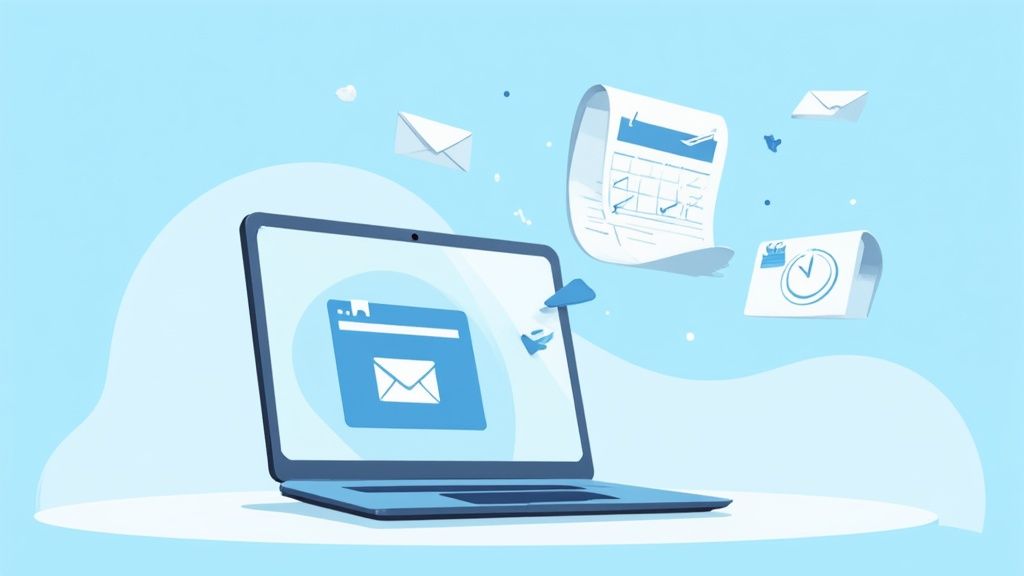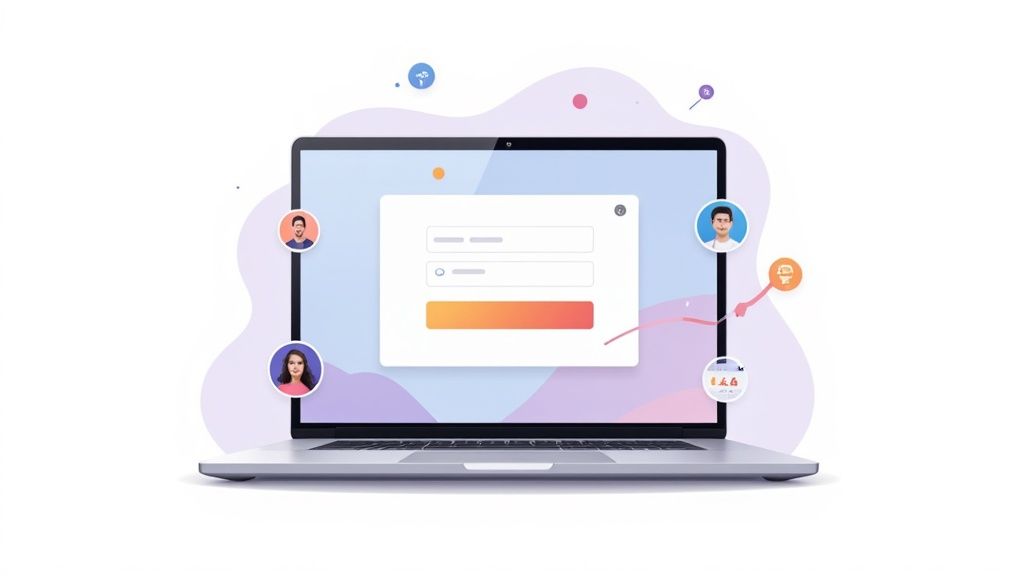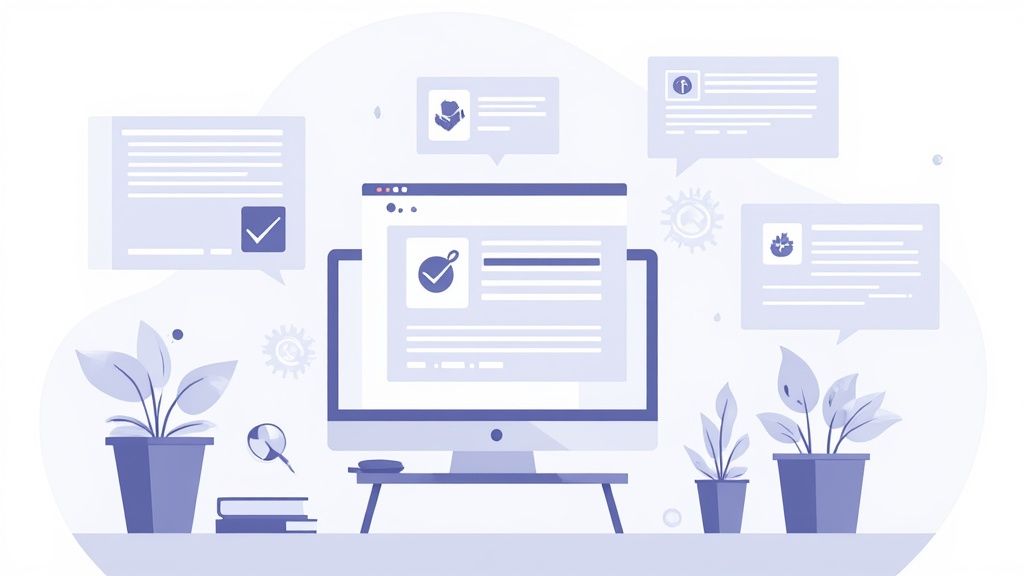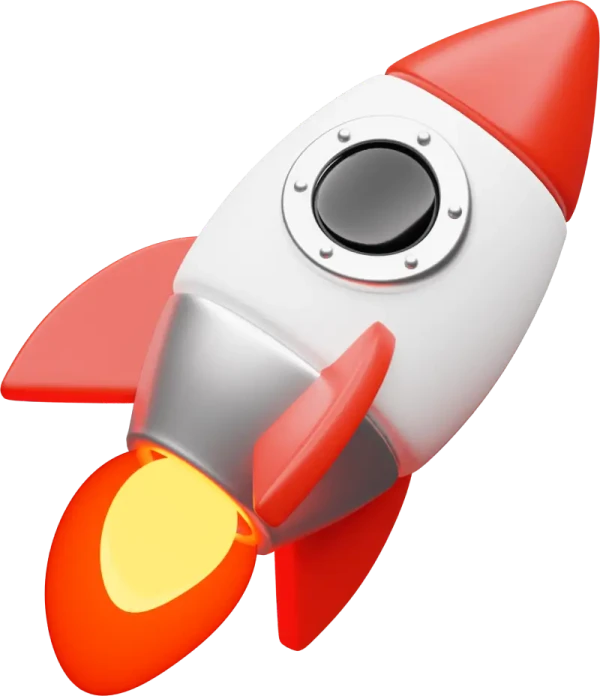An event reminder email is your secret weapon against no-shows. It’s a strategic nudge sent to everyone who registered, designed to keep your event top-of-mind and build some real excitement. Think of it as far more than a simple poke; it’s a critical tool for confirming details and sharing last-minute info.
Why Event Reminders Are Key to a Full House
Let's be real: no-shows can kill an otherwise great event. You've done all the hard work to get people signed up, but getting them to actually show up is a whole different ballgame. This is where a smart event reminder email strategy becomes your most valuable player.
Think about it from your attendees' perspective. They have busy lives, overflowing inboxes, and a dozen other things competing for their attention. That confirmation email you received weeks ago? It’s ancient history. A well-timed reminder cuts right through that noise and puts your event back on their radar when it matters most.
It's More Than a Single Message
A common mistake we see is sending just one, last-ditch reminder. A truly effective strategy is a sequence of emails, each with a clear purpose. This isn't just about jogging someone's memory; it's about building a steady drumbeat of anticipation and constantly reinforcing why they signed up in the first place.
A well-planned reminder cadence gives you some serious benefits:
- It keeps your event top-of-mind in a ridiculously crowded digital space.
- It delivers essential info (like parking tips or login links) exactly when they need it.
- It builds excitement by teasing speakers, sessions, or other unique perks.
- It reduces friction and last-minute panic, which leads to a much better experience for everyone.
As the Social Media Manager for Add to Calendar PRO, I’ve seen time and again that direct channels like email blow social media algorithms out of the water for critical updates. An email lands right in their inbox - it’s a reliable way to make sure they get the message.
A strong reminder strategy isn't just about fighting no-shows. It's an extension of your event's brand and a promise of a well-organized, valuable experience.
The Real-World Impact on Attendance
The numbers don't lie. There's a direct line between sending reminders and getting people through the door. One major tech conference, for example, saw a 30% drop in no-shows after they switched from a single, generic email to a multi-message sequence.
And since a whopping 77% of B2B buyers prefer professional communication via email, it's clear this is the channel to focus on for your most important event messaging.
Of course, digital is only part of the puzzle. Physical elements like effective signage for boosting event turnout are also crucial. When you combine a strong digital reminder game with a solid physical presence, you create a seamless, professional experience that encourages attendance from every possible angle.
Writing Subject Lines That Actually Get Opened
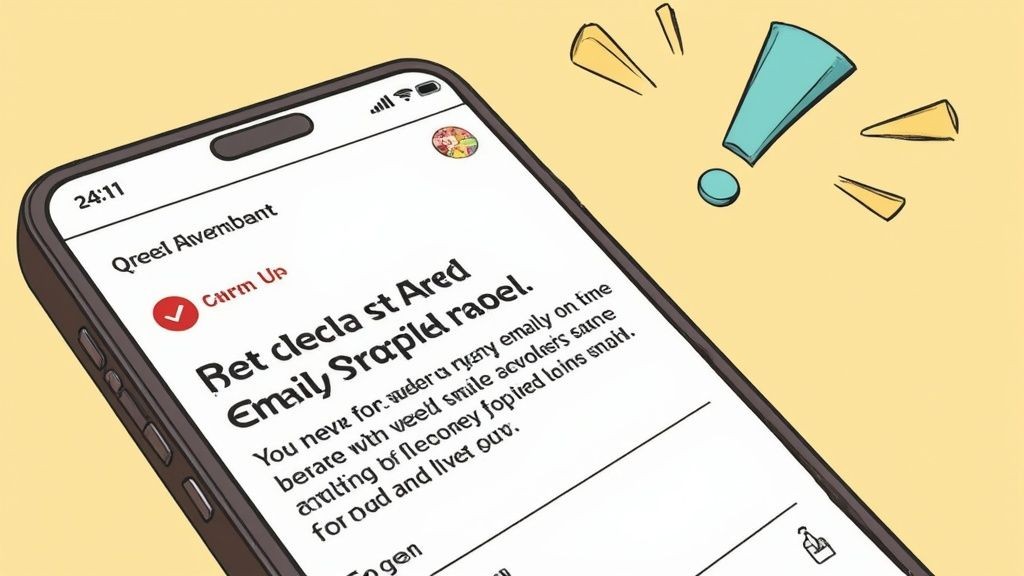
Let’s be honest, your subject line is the gatekeeper to your entire event reminder. If it doesn't grab attention in a split second, the beautiful, informative email you wrote might as well not exist.
Think about your own inbox. It’s a battlefield. A generic subject line like "Event Reminder" is practically invisible - it's the first thing people scroll past.
To get those opens, your subject line has to do a few things almost instantly: be clear, feel relevant, and spark just enough curiosity or urgency. This doesn't mean you have to resort to clickbait. A subtle, well-crafted line is always more effective. For instance, data shows that personalization can boost open rates by up to 50%. Just dropping in an attendee's first name can make a world of difference.
Creating Urgency Without Sounding Spammy
Urgency is a powerful motivator, but it’s a tightrope walk. You want to prompt action, not make people roll their eyes. The secret is to be helpful and specific. Instead of a vague warning, frame the urgency around a benefit for the attendee.
This approach feels less like pressure and more like a friendly heads-up, which encourages a click instead of a trip to the trash folder.
Check out these examples:
- For a webinar: "Reminder: Your access link for tomorrow's SEO Masterclass"
- For a conference: "Heads up: Final schedule for the Innovate Summit this week"
- For a workshop: "Name, just 2 days until our exclusive design workshop"
See how each one is direct and packed with vital info? That's what makes it immediately relevant.
Clarity and Personalization Always Win
Beyond urgency, clarity is your best friend. The whole point of a reminder email is to inform, so just say what it is right in the subject line. When you combine that directness with a touch of personalization, you've got a winning formula.
A great subject line makes a promise that the email content has to deliver on. Be direct and honest about what's inside - attendees appreciate knowing what to expect before they even open the email.
Here are a few more high-performing examples from what we've seen work:
- To build some excitement: "🎉 Are you ready for Event Name?"
- For pure logistics: "Everything you need for Thursday's conference"
- For that last-minute nudge: "See you in an hour for the Webinar Name!"
A strategically placed emoji can help you stand out, but don't overdo it. Make sure it fits your brand's voice.
But here’s the most important tip: A/B test your subject lines. Seriously. Pit a personalized version against a non-personalized one, or try a question against a statement. The data doesn't lie, and it will tell you exactly what your audience responds to, helping you nail it every time.
Structuring Your Email for Maximum Impact
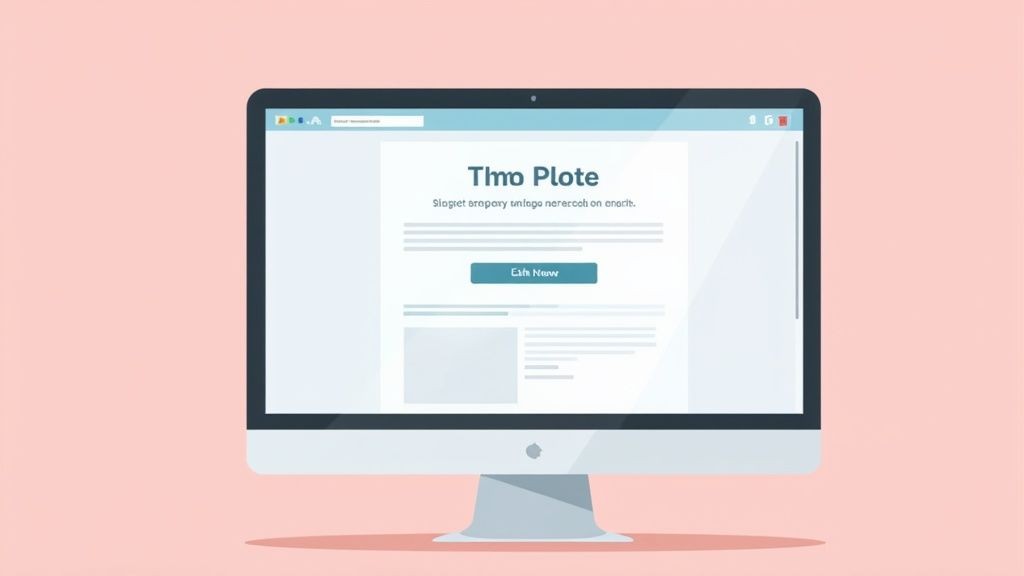
The moment someone opens your reminder, the clock is ticking. You have just a few seconds to get the essential info across before they move on. This is where smart design comes in.
Your email needs to be instantly scannable, informative, and persuasive. A cluttered, confusing layout doesn't just look bad; it subconsciously signals that your event might be just as disorganized.
The best way to tackle this is with an "inverted pyramid" structure. Get the most critical information right at the top. Even if someone only glances at it, they should get the main point. Don't make them hunt for the basics.
Lead With the Essentials
Your attendees are busy people. The most respectful thing you can do is put the "what, when, and where" front and center. This information should be impossible to miss, sitting right there after your opening hello.
This isn't just about the words you use; it's about visual hierarchy. Use clear headings, maybe some bullet points, and bold text to pull the reader's eye straight to these key details. Think of it as creating a quick visual map of what they need to know.
A simple, effective way to lay this out is:
- Event: Your Event Name
- Date: Day, Month Date, Year
- Time: Start Time - End Time (Timezone)
- Location: Venue Address or Virtual Link
This format is clean, universally understood, and does its job instantly.
Drive Action With a Powerful CTA
Okay, so they know the basics. Now what? Your next job is to get them to take action. Every great event reminder needs a clear, compelling call-to-action (CTA).
This should be more than just a hyperlink. A good CTA is a button that stands out visually and uses action-oriented language.
But here’s a pro tip: the most powerful CTA in an event reminder isn't "Learn More" or "View Details." It's one that helps them lock in their commitment. And the best way to do that? Get your event onto their personal calendar.
A registration confirmation is a good start, but an event added to a personal calendar is a genuine commitment. It transforms a simple intention into a scheduled, blocked-off appointment.
This is exactly why Add to Calendar PRO was created. There was a clear need to make this critical step seamless for everyone involved. Instead of a generic link, you can drop a clean, professional "Add to Calendar" button right into your email.
Here’s a peek at how easily you can customize our buttons to fit your brand.

This screenshot shows the no-code customization options inside our service. You can match the button's style and text perfectly to your email design. With just one click, your attendees can add the event to their Google Calendar, Outlook, or Apple Calendar. It’s a small step that dramatically increases the odds they'll actually show up.
The Art and Science of Timing Your Reminders
You can craft the most brilliant event reminder email in the world, but if you send it at the wrong time, it’s like telling a great joke to an empty room. The impact is completely lost.
Timing isn’t just some minor detail; it’s a strategic lever that can make or break your attendance rates. Send too many reminders, and you risk annoying your audience right into the unsubscribe link. Send too few, and they might forget about your event altogether.
The goal is to find that sweet spot - a cadence that keeps your event on their radar without becoming just another piece of inbox clutter. And it's important to note, there's no magic one-size-fits-all formula. The right schedule depends entirely on the type of event you're hosting and the audience you're trying to reach.
This infographic breaks down a simple but incredibly effective three-stage reminder process.
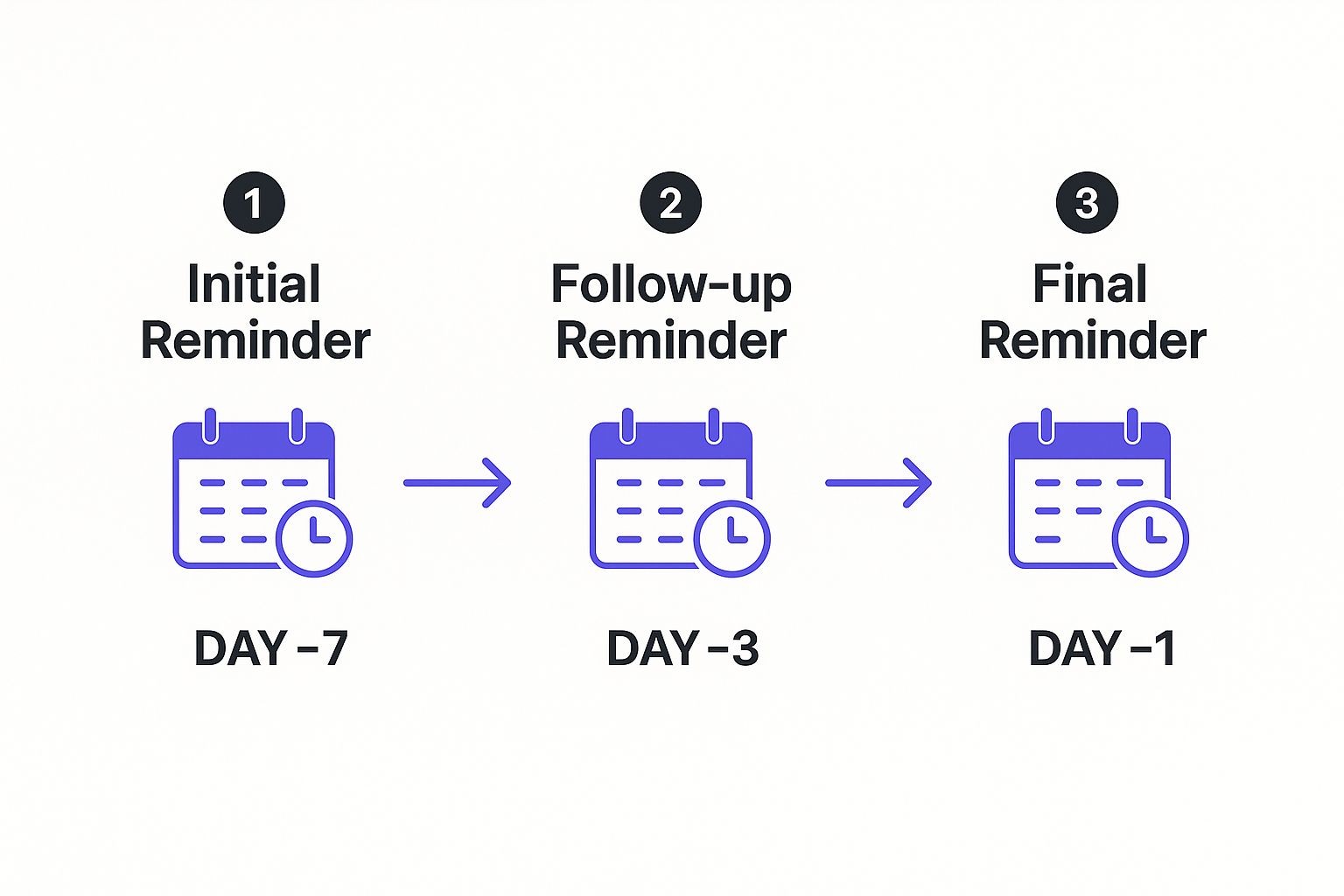
It’s a powerful flow, moving from an initial heads-up to a final nudge, ensuring your attendees stay plugged in as the event gets closer.
Your Cadence Depends on Your Event
Different events demand different communication rhythms. A webinar is a much lower commitment than a multi-day conference, so your reminder strategy has to reflect that.
For a webinar, it's pretty common to send reminders one week out, one day before, and a final one an hour before showtime. This works perfectly for online events where people often decide to join at the last minute.
On the other hand, a major in-person conference needs a much longer runway. Your attendees have to book flights, sort out hotels, and clear their schedules. For these bigger events, a schedule of two weeks out, three days before, and the morning of the event works far better. That final email becomes a logistical powerhouse, packed with details on parking, check-in, and the day's agenda.
The job of your final reminder changes completely based on the event format. For a virtual event, it’s all about the access link. For an in-person one, it’s more of a pocket travel guide. Always tailor your content to what the attendee needs at that exact moment.
To help you visualize this, we've put together a table with some recommended cadences that have proven to work well for different event types.
Recommended Event Reminder Email Cadence
Here’s a look at some battle-tested email schedules for a few common event types. Think of these as a starting point; you should always test and see what resonates with your specific audience.
| Timing | Webinar / Virtual Event | In-Person Conference | Exclusive Workshop |
|---|---|---|---|
| 2 Weeks Out | Optional: "Get excited" email with speaker intros. | Crucial: Travel and accommodation reminders. | Essential: Pre-work or agenda preview. |
| 1 Week Out | Standard reminder with agenda highlights. | "Know before you go" email with key logistics. | Detailed agenda and what to bring. |
| 3 Days Out | Optional: "Don't miss out" with a key takeaway. | Final logistics check-in (parking, registration). | Final reminder and opportunity for questions. |
| 1 Day Out | Essential: "See you tomorrow!" with login details. | "See you tomorrow!" with on-site map/schedule. | "See you tomorrow!" with location details. |
| 1 Hour Out | Essential: "We're starting soon!" with a direct link. | N/A | N/A |
| Morning Of | N/A | "Welcome!" with key session times and info. | A simple "Looking forward to seeing you" text. |
This table shows how the "why" behind each reminder shifts. For a conference, it's about logistics. For a workshop, it's about preparation. Always think about what your attendee needs to know, and when they need to know it.
Segment Your Audience for Better Timing
Beyond just the event type, you have to consider when someone registered. An attendee who signed up six months ago needs a very different nurturing sequence than someone who just registered last week.
- Early Birds: These are your most engaged folks, but they also have the most time to forget. Keep them hooked with a monthly or bi-monthly "excitement-building" email. Think speaker spotlights, session previews, or behind-the-scenes content.
- Recent Registrants: For people who signed up closer to the date, your standard reminder cadence (like one week out, one day out) is usually all they need. There's no reason to bombard them with the long-term nurture sequence.
This segmented approach isn't just smart marketing; it shows you respect their time and understand their context. It feels more personal and is way more effective than a generic email blast to your entire list. For more deep-dive strategies, check out our guide on crafting the perfect event email reminder.
And my final pro tip: always, always respect time zones. Sending a reminder at 2 AM is a surefire way to get ignored or marked as spam. Use your email marketing platform's scheduling features to deliver your message during your audience's local business hours. It dramatically increases the chances it gets seen and opened right away.
Advanced Tips for Engaging Reminders
You've got the basics down - the structure is solid, and your timing is on point. But now it’s time to take your event reminder emails from pretty good to unforgettable. This is where you move beyond generic blasts and start building a real community around your events, ensuring people don't just show up, but actually remember the experience.
Going advanced isn't about some crazy, complicated new system. It’s about being more thoughtful. It’s about being more relevant to every single person who signed up. This means taking a closer look at who your attendees are and what they’ve told you, even in subtle ways.
Segment Your Audience for Hyper-Relevance
This is probably the most powerful tool in your arsenal for creating a personal connection. Instead of carpet-bombing your entire list with the same exact email, you can tailor the content based on data you probably already have.
Think about it: did your registration form ask which sessions or tracks attendees were most interested in? Use that! Send a targeted reminder that spotlights the specific speakers or topics they said they cared about. This one small tweak transforms a generic broadcast into a personalized itinerary. It shows you're paying attention and hammers home the unique value they will get from being there.
Mobile Optimization Is Non-Negotiable
Okay, this isn't so much a "tip" as it is a hard-and-fast rule. More than half of all emails get opened on a mobile device. If your email looks like a jumbled mess on a small screen, it’s going straight to the trash. No questions asked.
Your reminders have to look and work perfectly on any device. That means:
- Stick to a single-column layout.
- Keep your text short, sweet, and scannable.
- Make sure your buttons and links are big enough for a thumb to tap easily.
- Optimize your images so they load fast and don't eat up a ton of data.
A clunky mobile experience just feels unprofessional. It creates friction and annoyance right when you want people to be getting excited.
The sheer scale of email is mind-boggling. By 2025, an estimated 4.6 billion people will use email, firing off nearly 376 billion emails every single day. With 60% of consumers saying they prefer to hear from brands via email, a mobile-first approach isn't just a good idea - it's meeting your audience where they live.
Extend the Conversation Post-Event
Don't go silent the moment your event ends. A post-event follow-up is a natural and necessary part of your reminder sequence. It's your best chance to nurture that long-term relationship.
This is your opportunity to thank everyone for coming, share the presentation slides or recordings, and - this is key - ask for valuable feedback with a quick survey.
This final touchpoint reinforces all the value you just provided and keeps the conversation alive. It proves your goal wasn't just to get bodies in seats, but to deliver a genuinely valuable experience from start to finish. Plus, it’s the perfect setup for announcing your next big thing.
Ultimately, a sophisticated reminder strategy is all about building a loyal community. Integrating professional tools, like our Add to Calendar PRO buttons, helps make the entire experience feel polished and user-friendly. For a deeper dive into crafting these messages, check out our other articles on email event reminders.
Common Event Reminder Questions Answered
Even the most seasoned event organizer runs into questions when setting up reminder emails. It's just part of the game. Let's walk through some of the most common ones we hear, so you can get clear, practical answers and get back to planning.
How Many Reminder Emails Should I Send?
The sweet spot for most events is two to three reminders. A sequence that works wonders is: send one a week out, another the day before, and a final one on the day of the event. For webinars, that last one is often just an hour before showtime.
But don't treat this as a rigid rule. If you're running a huge conference that attendees booked months ago, an extra reminder a month out makes a lot of sense. The real key is to pack new value into each email. Don’t just say the same thing three times. Use later emails to share speaker bios, session schedules, or helpful travel tips.
What Should I Do If My Open Rates Are Low?
Low open rates almost always circle back to one thing: the subject line. Is it clear? Is it compelling? Does it feel personal? The very first thing you should do is A/B test a few different versions to see what your audience actually clicks on.
Next, take a hard look at your timing. Are you sending emails when your audience is most likely to be glued to their inbox? Dig into your email platform’s analytics to pinpoint those peak engagement windows. And finally, think about your sender reputation. The best long-term fix is to consistently send awesome content that people genuinely want to open.
Proactively answering attendee questions in your emails - maybe in a short FAQ section - can massively cut down on last-minute confusion. Covering things like parking, dress code, or where to find post-event resources makes people feel prepared and more committed to showing up.
Can I Use the Same Reminder Email for Every Event?
You absolutely can - and should - create a base template to save time. But never, ever send the exact same email for different events. You have to customize each reminder to fit the event's specific vibe, audience, and format.
A reminder for a formal B2B webinar needs a completely different voice than one for a casual community meetup. Always tailor the key details, the value proposition, and the call-to-action. For example, if you're managing registrations, our guide on how to create an RSVP link can help you customize that critical part of your email. It’s a small effort, but it makes a huge difference in how your message lands.
Ready to make your events unmissable? With Add to Calendar PRO, you can easily add professional, one-click calendar buttons to all your emails and landing pages, drastically reducing no-shows. Start creating seamless event experiences today at https://add-to-calendar-pro.com.
